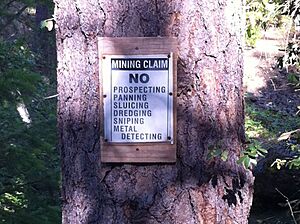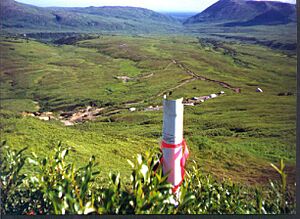Land claim facts for kids

Have you ever heard someone say they "claimed" something? A land claim is when a person or a group says they own a piece of land. This idea usually comes up when there's a disagreement about who the land belongs to, or if its ownership isn't clear yet.
For example, some land claims involve Indigenous peoples asking for their traditional lands back. Other claims might be about parts of Antarctica or lands that were once controlled by other countries (these are called post-colonial claims). Sometimes, the term is used for places where people are arguing over borders, like Western Sahara.
Long ago, during the colonial period in the United States, people could try to claim land for themselves. How strong their claim was depended on what they actually did with the land:
- If they just said they wanted it, but did nothing.
- If they put some of their belongings on the land.
- If they visited the land often.
- If they actually lived on the land.
Today, most land around the world is already owned. However, some large areas, especially in places like Alaska, might still be available for very low prices. In some parts of the world, you can still get land by using it productively, like for farming.
Mining Claims: Digging for Riches
A mining claim is a special type of land claim. It's a right to search for and take out minerals from public land. Imagine finding gold or silver! This idea became popular in the United States during the California gold rush in 1849.
Back then, there wasn't much government control in the mining areas. So, miners made their own rules. They often used ideas from Mexican mining laws. These laws said that the first person to find minerals and start digging had the right to mine that spot. The size of the area they could claim was usually limited to what one person or a small team could work.
This system of mining claims is based on an idea called prior appropriation. It means that public land or resources can be given to the first person who uses them in a helpful way. Another example of this idea was the Homestead Act. This law gave public land to farmers who promised to live on it and farm it. Water rights in the western U.S. also followed a similar rule.
The miners from California helped spread the idea of mining claims across the western United States. The U.S. Congress officially made this practice a law in 1866 and updated it with the Mining Act of 1872. This meant that any federal land not set aside for a special purpose could be claimed for mining. Even though the mining laws have changed over the years, some parts are still similar to the rules the California miners, known as the 49ers, first created.
Mining claims weren't just an American idea. They were also used in other countries, like during the Australian gold rushes that started around the 1850s. Many miners traveled from the American gold rushes to Australia, bringing their ideas with them. The Oriental Claims in Victoria are a good example of this.
How to "Stake" a Claim
To "stake" a mining claim, you first need to find a valuable mineral. It must be enough mineral that a smart person would think it's worth spending time and money to dig it up. This is sometimes called the "Prudent Man Rule."
After finding the mineral, you need to mark the edges of your claim. Miners often used wooden posts, metal posts, or piles of stones called cairns. These markers had to be a certain height. Finally, you had to officially register your claim with the government office that manages public lands, like the U.S. Forest Service (USFS) or the Bureau of Land Management (BLM), and also with the local county office.
There are four main kinds of mining claims:
- Placer claims: These are for minerals, like gold flakes, that are loose and found in stream beds or old river channels.
- Lode claims: These are for minerals that are still inside the solid rock, like a vein of gold.
- Tunnel claims: This is for a planned tunnel. It lets you claim any mineral veins you find while digging the tunnel.
- Millsite claims: This is a small area, up to five acres, used for processing the minerals you dig up.
When you first make a mining claim, it's called an unpatented claim. To keep it, you have to keep mining or exploring the land. Or, you can pay a yearly fee to the land management agency by September 1st. If you don't, your claim can be lost. The activities you do on an unpatented claim must be related to mining.
A patented claim is different. It means the federal government has given you a deed, like a title, to the land. To get a patented claim, you had to prove that there were enough valuable minerals to make a profit. Once patented, you could use the land for anything you wanted, just like any other private property. However, the U.S. Congress stopped providing money for this process. So, right now, you cannot get a patented claim.
What is Claim Jumping?
Imagine you've worked hard to find and mark your mining claim. If someone else tries to take over that land, even though you've already claimed it, that's called "claim jumping." It's a dispute where one person tries to steal another person's claim.
See also
- Gold placer claim
- Indigenous land claims in Canada
- Indigenous specific land claims in Canada
- Land grant
- Land rights
- Land reform
- Terra nullius (no man's land)
- Guano Islands Act
- Extraterrestrial real estate
- Claim club
- Land reform in South Africa


